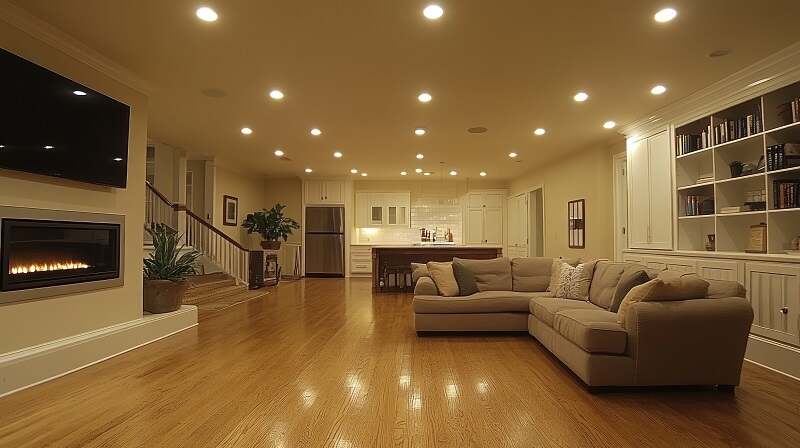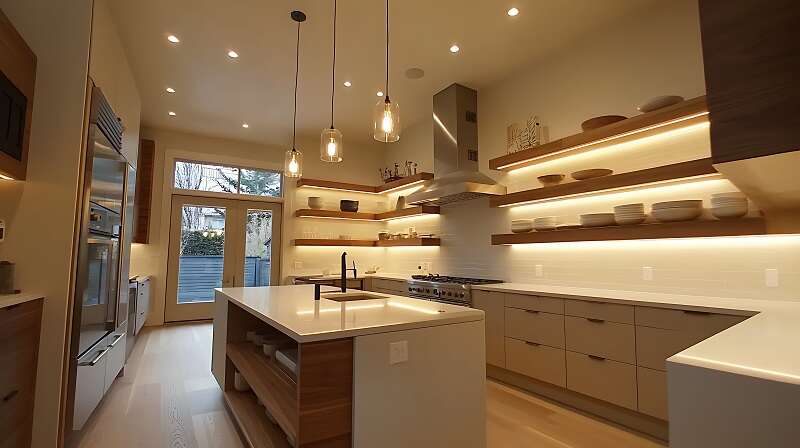You might not know how much lighting affects the look of your home. With the correct lighting, rooms can feel warmer, brighter, and more welcoming. On the other hand, bad lighting can make rooms look drab or uncomfortable. Lighting influences more than just how things look. It also affects how well each area supports your everyday activities, from cooking to relaxing before bed.
When you plan modifications with a purpose, you may make places that are both useful and beautiful, and that fit your lifestyle. Thoughtful lighting design can drastically affect how your house feels and works, whether you’re updating existing fixtures or making better use of energy.
Read on to find out how to design lighting upgrades that will make every space in your house seem its best.
Plan for Energy Efficiency and Future Needs
Smart lighting makes your home brighter, uses less energy, and maintains your system up to date. Planning ahead helps you save money on utilities and stops you from having to constantly alter your wiring or equipment as your needs change.
Here are the following aspects to think about for a lighting system that is both useful and forward-thinking:
Energy-efficient solutions
Informed designers and electricians no longer see lighting as a simple choice of wattage; it’s a calculation of lumens, color temperature, and longevity. The industry standard for efficiency and performance is unequivocally the Light Emitting Diode (LED). Unlike incandescent bulbs, which waste 90% of their energy as heat, a high Color Rendering Index (CRI) LED is engineered to convert almost all its energy into visible light.
This results in a cooler, safer fixture and can reduce the risk of combustion in enclosed spaces. For a typical household, a full shift to LEDs can reduce annual energy consumption by over 1,000 kWh.
Sustainable choices
Real sustainability in lighting means choosing options that help the planet every time you turn a light on. That’s why ENERGY STAR-certified products are often recommended for any upgrade focused on eco-friendliness.
Think of the ENERGY STAR label as your guarantee of integrity. To earn it, a fixture or bulb must pass rigorous, third-party testing for efficiency, light quality, and longevity, set by the U.S. Environmental Protection Agency.
Future flexibility
Think of your lighting plan not for the home you have today, but for the home you’ll evolve into. The most common and costly mistake is installing the bare minimum wiring. Instead, insist your electrician pulls a dedicated neutral wire and leaves ample capacity in your junction boxes.
This single, foresighted decision is your insurance policy. When you decide to install that stunning pendant light over the dining table next year or integrate a whole-home smart system, you won’t be facing thousands of dollars in drywall repair and rewiring.
When you update your lighting system, safety and usefulness should always come first. If you choose a certified electrician, you can be sure that your electrical system can handle any new installations. You can click here to find reliable professionals who can set up and arrange your new lighting the right way. They can check out your current wiring, recommend the best fixes, and help you set up a system that will meet your needs now and in the future.
Assess Each Room’s Purpose and Lighting Needs
Your lighting strategy should meet the needs of each area in your home, since each one has a different purpose. Thinking about how each room will be utilized during the day can help make sure that everyone is comfortable, that the space is useful, and that the correct mood is set for each activity.
To arrange lighting that works for each room’s purpose, think about the following:
Kitchen
In kitchen design, lighting is a critical tool for both safety and efficiency, and the industry standard is a strategic three-tiered approach. This begins with an ambient layer of recessed lights spaced to provide shadowless general illumination. The essential task layer then relies on direct, high-output solutions like 2700K LED strips producing at least 500 lumens per foot to fully illuminate countertop work surfaces.
Living room
Your living room is your home’s chameleon, transforming from a vibrant social space for game night into a cozy sanctuary for movie night. To achieve this effortlessly, you must master the art of layered, flexible lighting. Start by ditching the single, harsh overhead fixture. Instead, create a base of soft, ambient light from a central source on a dimmer.
Then, strategically place adjustable floor lamps with 3000K warm-white bulbs beside your main seating for reading, and install wall sconces with upward-facing shades to wash the walls in a warm glow.
Bedroom
Your bedroom shouldn’t be as bright as your home office. The point is to tell your brain that it’s time to relax and not get more energy. It starts with demanding warm-toned lighting of 2700 Kelvin or lower. This means a mellow, amber glow that looks like sunset, not the blue-heavy light of screens that keeps melatonin from being made.
Anchor your space with a dimmable ceiling fixture set to no more than 50% capacity for a general, soothing wash. Then, empower your bedside with swing-arm wall lamps, which you can adjust to cast a perfect pool of light onto your book without disturbing your partner.
Bathroom
Your bathroom serves two distinct roles: a functional grooming studio and a personal spa. To master both, you need a two-zone lighting plan. For your “get-ready” zone, flank your mirror with vertical sconces or a LED light bar placed at eye level about 66 inches from the floor. This placement casts even, shadow-free light across your face, eliminating the unflattering shadows a single overhead light creates.
For your “wind-down” zone, choose a ceiling light that’s dimmable and glows warm at 2700K. You can go from bright and clear for makeup to soft and soothing for a relaxing bath just by turning the dimmer.
Your home feels more put together, friendly, and like it fits your lifestyle when the lights in each room are exactly perfect.
Layer Different Types of Lighting
The ideal lighting for each room is a blend that works for different tasks and moods. Using more than one light source makes your area look deeper and helps you change the brightness to meet the time or event.
To get this right, include these lighting types:
Ambient lighting
Start by focusing on your room’s ambient lighting. Think of this as the sky above, providing soft, even light that removes harsh shadows and opens up the space. Avoid relying on one bright ceiling fixture. Instead, use several recessed downlights placed about four to six feet apart. A large, dimmable pendant with a wide shade can also work well by gently spreading light throughout the room.
Task lighting
Think about the last time you had to hunch over to see a detail in a shadow. That’s a task lighting failure. This layer is your personal spotlight, designed for what you do, not just how the room feels. The secret is strategic placement and control.
For you, this means choosing a desk lamp with a long, articulated arm that puts the light where your hands are, not in your eyes. The goal is to position the light source so that it shines on the task.
Accent lighting
You know that feeling when a room just clicks and feels full of life? That’s accent lighting doing its magic. While ambient light fills the space and task light helps you get things done, accent lighting highlights what makes the room special. It adds personality and makes the space feel alive.
Think of accent lighting as the jewelry that finishes your home’s look. It’s a focused beam from a track light that makes your favorite artwork stand out. It’s also the warm LED glow under your floating vanity that gives your bathroom a fresh, modern feel.
You can influence the mood and function of a room by using these three levels of light together.
Choose the Right Fixtures and Bulbs
In professional design, choosing fixtures and bulbs is a careful process, not just an afterthought. Fixtures must fit the style of the space, like sleek cylindrical paper pendants for a minimalist look or polished brass sconces for a transitional vibe. Each selection helps keep the room’s style consistent.
The technical details of the bulb are just as important. For practical areas like kitchens and workplaces, the industry standard is an LED light with a Color Rendering Index (CRI) of 90 or higher and a correlated color temperature (CCT) of 2700K to 3500K, depending on the mood you want to create. This makes sure that everything look right and are comfortable.
Maximize Natural Light
Natural light brightens your home without extra cost. Learn to work with it by mapping where morning rays come in gently and where afternoon light hits hard. This careful watching sets the stage for how you control your space.
With this map, you can deploy your tools with precision. Install motorized, light-filtering shades that automatically adjust to block harsh noon sun while preserving your view. Paint your walls in a high-Light Reflective Value (LRV) color like a soft satin-finish ivory to bounce light around like a pro.
Incorporate Smart Lighting Controls
Your lights are not just on or off anymore. Smart controls turn them into a system that adapts to your daily routine. Picture your kitchen lighting rising to half brightness as you make coffee with a “Good Morning” command. Or say “Movie Night” and watch the sconces dim to just 10%. This is the new standard for a customized and efficient home.
Start with smart dimmers to set the foundation. Then place motion sensors in low-traffic but important spots, such as the pantry or laundry room, so lights activate only when necessary. The last step is linking everything through a system like Philips Hue or Lutron Caséta. This setup helps reduce lighting energy use by up to 40% and shapes your home to fit your routine.
Final Thoughts
A great lighting plan comes from careful design. It starts with understanding your needs, using layered lighting, and choosing efficient, controllable sources. This approach turns your house into a comfortable, energy-smart home. The result is a space that looks balanced and adjusts easily to your daily routine.


